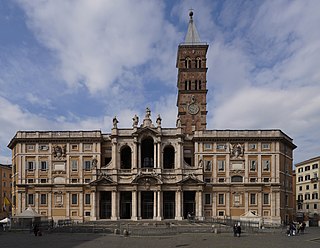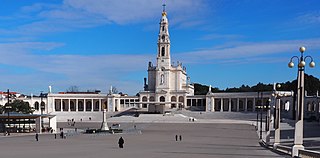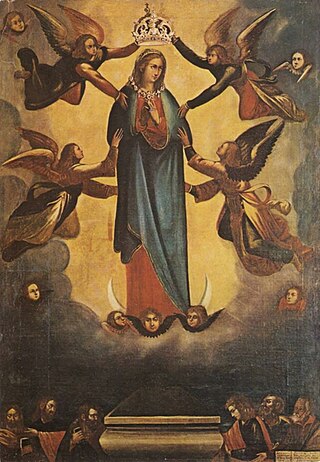
A shrine to the Virgin Mary, or Marian shrine, is a shrine marking an apparition or other miracle ascribed to the Blessed Virgin Mary, or a site on which is centered a historically strong Marian devotion. Such locales are often the destinations of Christian pilgrimages.

Għarb is an administrative unit of Malta, located at the westernmost point of the island of Gozo, with a population of 1,539 people.

Victoria, also known among the native Maltese as Rabat or by its title Città Victoria, is an administrative unit of Malta, and the main town on Gozo. Victoria has a total population of 6,901, and is the most populous settlement in Gozo.

The Basilica of the National Shrine of the Blessed Virgin of Ta' Pinu is a Roman Catholic minor basilica and national shrine located some 700 metres (2,300 ft) from the village of Għarb on the island of Gozo, the sister island of Malta.

Our Lady of Lourdes is a title of the Virgin Mary. She is venerated under this title by the Roman Catholic Church due to her apparitions that occurred in Lourdes, France. The first apparition of 11 February 1858, of which Bernadette Soubirous told her mother that a "Lady" spoke to her in the cave of Massabielle while she was gathering firewood with her sister and a friend. Similar apparitions of the "Lady" were reported on 18 occasions that year, until the climax revelation in which she introduced herself as: "the Immaculate Conception". On 18 January 1862, the local Bishop of Tarbes Bertrand-Sévère Laurence endorsed the veneration of the Blessed Virgin Mary in Lourdes.

The Diocese of Gozo is a Latin diocese of the Catholic Church in Malta, and the only suffragan in the ecclesiastical province of the Metropolitan Archdiocese of Malta, together covering the insular state.

The Sanctuary of Las Lajas is a Catholic minor basilica located within the canyon of the Guáitara River in Ipiales, Nariño Department, Colombia. The Marian shrine is dedicated to the Blessed Virgin Mary as Our Lady of the Rosary.

St. George's Basilica or the Basilica and Collegiate Parish Church of Saint George, also simply known as San Ġorġ in Maltese, is a historic Baroque church situated in the middle of Gozo, the second largest island in the Maltese archipelago, and is surrounded by a maze of old narrow streets and alleys. The church had been rebuilt numerous times during the Middle Ages. Today's basilica was built between 1672 and 1678.

The Basilica of Our Lady of Good Health, also known as Sanctuary of Our Lady of Velankanni, is a Christian shrine located at the town of Velankanni, Tamil Nadu, India. The shrine is dedicated to the Blessed Virgin Mary.

Our Lady of Manaoag is a Roman Catholic title of the Blessed Virgin Mary venerated in Manaoag, Pangasinan, the Philippines. The sacred statue is referred to as Apo Baket in the native language of local devotees.

Our Lady of Laus or Refuge of Sinners denotes Marian apparitions that took place between 1664 and 1718 in Saint-Étienne-le-Laus, France, to Benoîte Rencurel, a young shepherdess. The apparitions were approved by the Holy See on 5 May 2008. Pope Pius IX granted a Canonical Coronation to her marble image on 23 May 1855.

Catholic Marian churches are religious buildings dedicated to the veneration of the Blessed Virgin Mary. These churches were built throughout the history of the Catholic Church, and today they can be found on every continent including Antarctica. The history of Marian church architecture tells the unfolding story of the development of Catholic Mariology.

The Sanctuary of Fátima, officially titled Sanctuary of Our Lady of the Rosary of Fátima, is a Marian shrine dedicated to Our Lady of Fatima located in Fátima, in the municipality of Ourém, in Portugal. It consists of a group of Catholic religious buildings and structures with the Basilica of Our Lady of the Rosary as the main building.

The Blessed Virgin of Ta' Pinu, or as it is known in Maltese, "Il-Madonna ta' Pinu" is a religious devotion which originated on Gozo, the sister island of Malta. The many Maltese and Gozitans living abroad have managed to spread this devotion in many other parts of the world. The Ta' Pinu Basilica, is based in Għarb.

Our Lady of Šiluva is Roman Catholic image of the Blessed Virgin Mary venerated at the Basilica of the Nativity of the Blessed Virgin Mary, Šiluva shrine in Lithuania. The patriotic icon is highly venerated in Lithuania and is often called Lithuania's greatest treasure.

Our Mother of Sheshan or Our Lady of Sheshan (佘山聖母), also known as Our Mother of Zo-sè, is a celebrated Marian title of the Blessed Virgin Mary venerated by Chinese Roman Catholics. Among its religious devotees, the statue is sometimes known as Our Lady of Luck or Our Lady of Good Luck due to the Chinese symbology of "Fu" (福) associated with the styling posture of the entire image. The original image is currently enshrined in the National Shrine and Minor Basilica of Our Lady of Sheshan, in Shanghai, China.

A pilgrimage church is a church to which pilgrimages are regularly made, or a church along a pilgrimage route, like the Way of St. James, that is visited by pilgrims.

Ġużepp Portelli was a Maltese Roman Catholic prelate who founded the present Ta' Pinu Basilica in Gozo.

Our Lady of Consolation or Mary, Comforter of the Afflicted is a title of the Blessed Virgin Mary venerated in the Catholic Church.




















